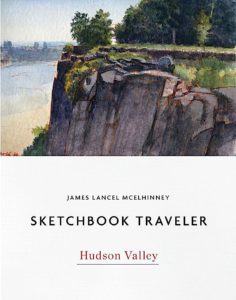Exploring the banks of the Schuylkill River in 2018, between the mouth of Wissahickon Creek and Fairmount Water-Works I filled a sketchbook with paintings. Later that year, a suite of prints drawn from this journal would become the centerpiece of an installation at Independence Seaport Museum in Philadelphia.

Boat House Row from behind Lloyd Hall. Schuylkill River Sketchbook. Wednesday August 8, 2018. 4:30 pm
At the foot of Lemon Hill on the left bank of the Schuylkill is a line of historic barge-clubs. Competitive amateur rowing was first inspired by races held between colonial-era oarsmen who ferried passengers and cargo to and from ships riding at anchor on the Delaware.
Wagers would be placed on these early contests, but as the sport developed, crews rowed for symbolic rewards; trophies and acclaim. The first organized regatta was held on November 12, 1835, an event depicted by Italian-American painter Nicolino Calyo (1799-1884)

The sport evolved in tandem with the development of Fairmount Park, a conglomeration of colonial estates atop the bluffs between the Water-Works and Laurel Hill Cemetery on the left bank; and from Girard Avenue to Belmont on the right. During the nineteenth century rowing-crews shared the waterway with canal-barges navigating between the locks at Manayunk and Fairmount dam. While a salubrious pastorale was being organized along its banks, the city’s primary water-supply was fouled with industrial and organic pollutants. Things got even worse below the dam. The canal ceased operations in 1931. In the 1950s, major cleanup efforts were underway. More than sixty years later wildlife has returned to its waters. Forty species of freshwater fish abide in its waters, hunted by wading-birds seen on its shores. Painted and snapping-turtles are common sights. At the western end of Fairmount dam, the Army Corps of Engineers built a fish-ladder to allow shad to spawn upstream.

Detail of an 1876 map created for the Centennial Exposition,
showing the location of boat-houses at lower right
In pursuing this project, a view of Boat House Row would be de riguer. Determined to avoid the familiar trope of the barge-clubs lined up cheek-to-jowl, I positioned myself behind Lloyd Hall. The building is in constant use, with basketball courts, public restrooms, a small coffee-shop, outdoor dining-area and bike-rental kiosk. A finger of water reaches east behind the building. Floating docks behind Lloyd hall served the Adaptive Rowing program created for people with sensory, mental or physical challenges. A number of the participants are veterans.
Across this narrow inlet is a peninsula, newly formed by silt, covered with a new-growth of trees. In 2018 the area was enclosed by chain-link fences, as work-crews built a nature-trail. Beyond this stretching south is a shaded parking-area that ends at the Azalea Garden roundabout. Further south is a broad grassy expanse covering the Forebay from which Fairmount Water-Works drew water. Its reservoir was later incorporated into the foundation of Philadelphia Museum of Art.
Looking west across the river gave me a foreshortened, unconventional view of the boathouses. Across the wide basin a green directional sign on the Schuylkill Expressway hovered about the leafy riverbank. Oarsmen and women embarked from floating docks behind the clubhouses. Behind Lloyd Hall is a series of grassy terraces enclosed by concrete risers. Using one of these as my perch, the work progressed. At the water’s edge a group of geese took note of my presence. Having been warned that these birds were aggressive and pugnacious, I ignored them and kept working. One of their number walked toward me. Approaching, he thrust forward his neck, horizontal to the ground. This gave me warning, or perhaps a challenge. The bird drew closer. I looked straight at him and calmly said “hello.” He stopped, raised his head, turned it this way and that to examine me.

Watch the video: IMG_6524
I repeated the greeting. Replying in kind he sat down, signaling his timorous posse to approach. One sat beside me. Another goose put his head in my bag, looking for snacks. One foraged my feet. Others kept their distance. Remaining calm, I moved as little as possible. After a while they grew bored, and drifted over to the dining area.
“Bye,” I said. Alpha-goose turned his head and gave me a look. A young woman and her daughter sat down to enjoy their ice-cream. The goose headed their way. The girl smiled.
“Don’t go messing with those mean dirty creatures,” said the mother.
Suddenly the temperature dropped. A cool breeze crossed the water. Dark clouds rolled in from the west. Golden sunlight danced on the river. Rain began to fall.
(A preview of SKETCHBOOK TRAVELER by James L. McElhinney (c) 2020. Schiffer Publishing).
Copyright James Lancel McElhinney (c) 2020 Texts and images may be reproduced (with proper citation) by permission of the author. To enquire, send a request to editions@needlewatcher.com
